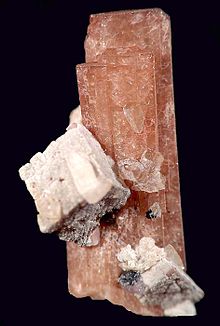Ancylite
| Ancylite | |
|---|---|
 Nenadkevichite with ancylite crystals on the side | |
| General | |
| Category | Carbonate mineral |
| Formula (repeating unit) | Sr(Ce,La)(CO3)2(OH)·H2O |
| Strunz classification | 5.DC.05 |
| Dana classification | 16b.1.1.1 |
| Crystal system | Orthorhombic |
| Crystal class | Dipyramidal (mmm) H-M symbol: (2/m 2/m 2/m) |
| Space group | Pmcn |
| Identification | |
| Color | Light yellow, orange-yellow, yellow-brown, grey |
| Cleavage | None |
| Fracture | Splintery |
| Tenacity | Brittle |
| Mohs scale hardness | 4–4.5 |
| Luster | Dull |
| Streak | White |
| Diaphaneity | Translucent |
| Density | 3.95 g/cm3 |
Ancylite (IMA symbol: Anc[1]) is a group of hydrous strontium carbonate minerals containing cerium, lanthanum and minor amounts of other rare-earth elements. The composition is Sr(Ce,La)(CO3)2(OH)·H2O with ancylite-Ce enriched in cerium and ancylite-La in lanthanum.[2][3]
Ancylite was first described in 1899 for an occurrence in the Narsarsuk pegmatite in west Greenland and named from the Greek αυκιλος for curved in reference to its rounded or distorted crystal form.[2][4]
References[]
- ^ Warr, L.N. (2021). "IMA-CNMNC approved mineral symbols". Mineralogical Magazine. 85: 291–320.
- ^ a b http://webmineral.com/data/Ancylite-(Ce).shtml Webmineral data Ancylite-Ce.
- ^ http://www.handbookofmineralogy.org/pdfs/ancylitela.pdf[permanent dead link] Handbook of Mineralogy.
- ^ http://www.mindat.org/min-216.html Mindat.
Categories:
- Carbonate minerals
- Strontium minerals
- Lanthanide minerals
- Orthorhombic minerals
- Minerals in space group 62
- Carbonate mineral stubs